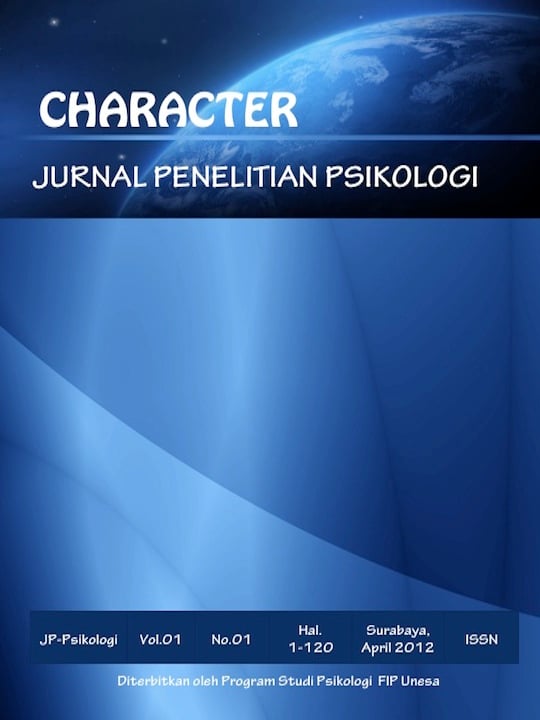DAMPAK SIBLING RIVALRY PADA REMAJA KEMBAR
DOI:
https://doi.org/10.26740/cjpp.v9i6.47432Abstract
Abstrak
Kehidupan anak kembar merupakan hal yang menarik untuk diteliti, termasuk dalam hal sibling rivalry atau biasa disebut sebagai persaingan antar saudara. Terlebih apabila hal tersebut terjadi pada saudara yang kembar identik, dengan usia yang sama, jenis kelamin yang sama dan memiliki kemiripan pada wajah. Penelitian ini bertujuan untuk mengetahui bagaimana dampak sibling rivalry terhadap perkembangan emosi remaja kembar identik. Pendekatan yang digunakan dalam penelitian ini adalah pendekatan kualitatif dengan metode fenomenologi. Teknik pengumpulan data yang digunakan yaitu wawancara semi-terstruktur. Partisipan dalam penelitian ini berjumlah 10 orang atau 5 pasang remaja kembar dengan ketentuan seorang remaja kembar secara identik yang berusia 16 sampai 19 tahun. Teknik analisis data penelitian menggunakan IPA (Interpretative Phenomenological Analysis). Berdasarkan penelitian yang telah dilakukan maka diperoleh hasil bahwa bentuk sibling rivalry dapat dijelaskan melalui pola asuh orang tua, hubungan dengan saudara kembar, dan lingkungan sosial. Sibling rivalry sesekali muncul diantara anak kembar seperti pada saat ingin bersaing untuk menunjukkan siapa yang lebih unggul, namun hal tersebut tidak berlangsung lama. Dampak dari sibling rivalry yang mengarah pada perkembangan emosional yaitu secara positif dapat ditunjukkan dari rendahnya sibling rivalry seperti pada saudara kembar yang merasa bahwa perhatian dan kasih sayang yang diberikan oleh orang tua telah melimpah dan adil. Selain itu, perkembangan emosi positif juga dimunculkan melalui saling memahami antar saudara kembar.
Kata Kunci: remaja kembar, sibling rivalry, perkembangan emosi.
Abstract
The life of twins is an interesting thing to study, including the competition between siblings. Especially if it happens to an identical sibling, of the same age, the same gender and has a similarity to the face. This study aims to determine how the impact of sibling rivalry on the emotional development of identical twins adolescents. The approach used in this research is a qualitative approach with a phenomenological method. The data collection technique used is semi-structured interview. Participants in this study found 10 people or 5 pairs of teenage twins with the provision of identical twins aged 16 to 19 years. The research data analysis technique uses IPA (Interpretative Phenomenological Analysis). Based on the research that has been done, it is obtained that the form of sibling rivalry can be explained through parenting patterns, relationships with twins, and social environment. Sibling rivalry arose between the twins as when competing to show who was superior, but it didn't last long. The impact of sibling rivalry that leads to emotional development can be positively demonstrated by the low level of sibling rivalry as in twins who feel that the attention and affection given by parents is abundant and fair. In addition, the development of positive emotions is also raised through mutual understanding between twins.
Keywords: twins, sibling rivalry, emotional development.
Downloads
Downloads
Published
How to Cite
Issue
Section
License
Authors who publish in this journal agree to the following terms:
Copyright in any article is held by the author.
The author grants the journal, publication rights with the work simultaneously licensed under a Creative Commons Attribution License that allows others to share the work with an acknowledgment of the work's authorship and initial publication in this journal.
Authors may enter into separate, additional contractual arrangements for the non-exclusive distribution of the journal's published version of the work (e.g., posting it to an institutional repository or publishing it in a book), with an acknowledgment of its initial publication in this journal.
Authors are permitted and encouraged to post their work online (e.g., in an institutional repository or on their website) prior to and during the submission process, as this can lead to productive exchanges, as well as earlier and greater citation of published work.
 Abstract views: 889
,
Abstract views: 889
, PDF Downloads: 717
PDF Downloads: 717





